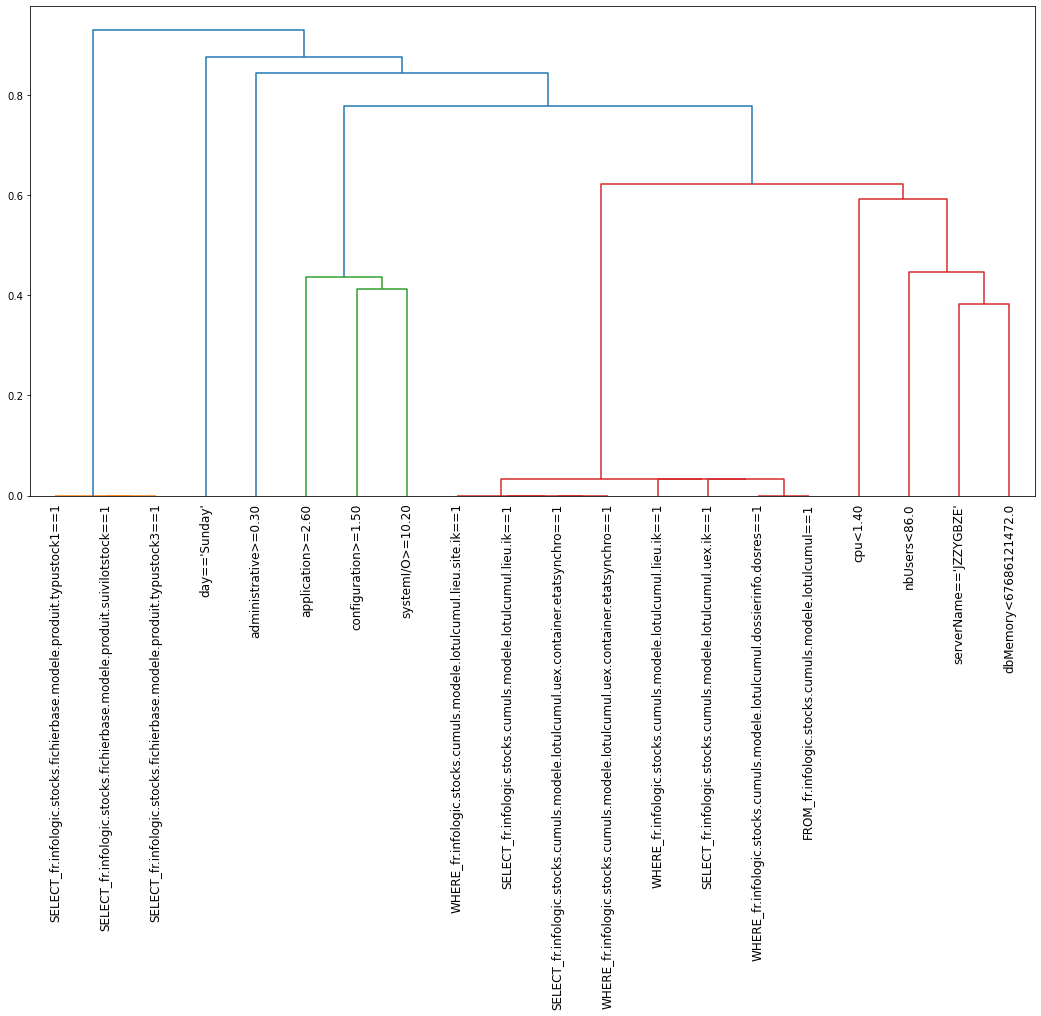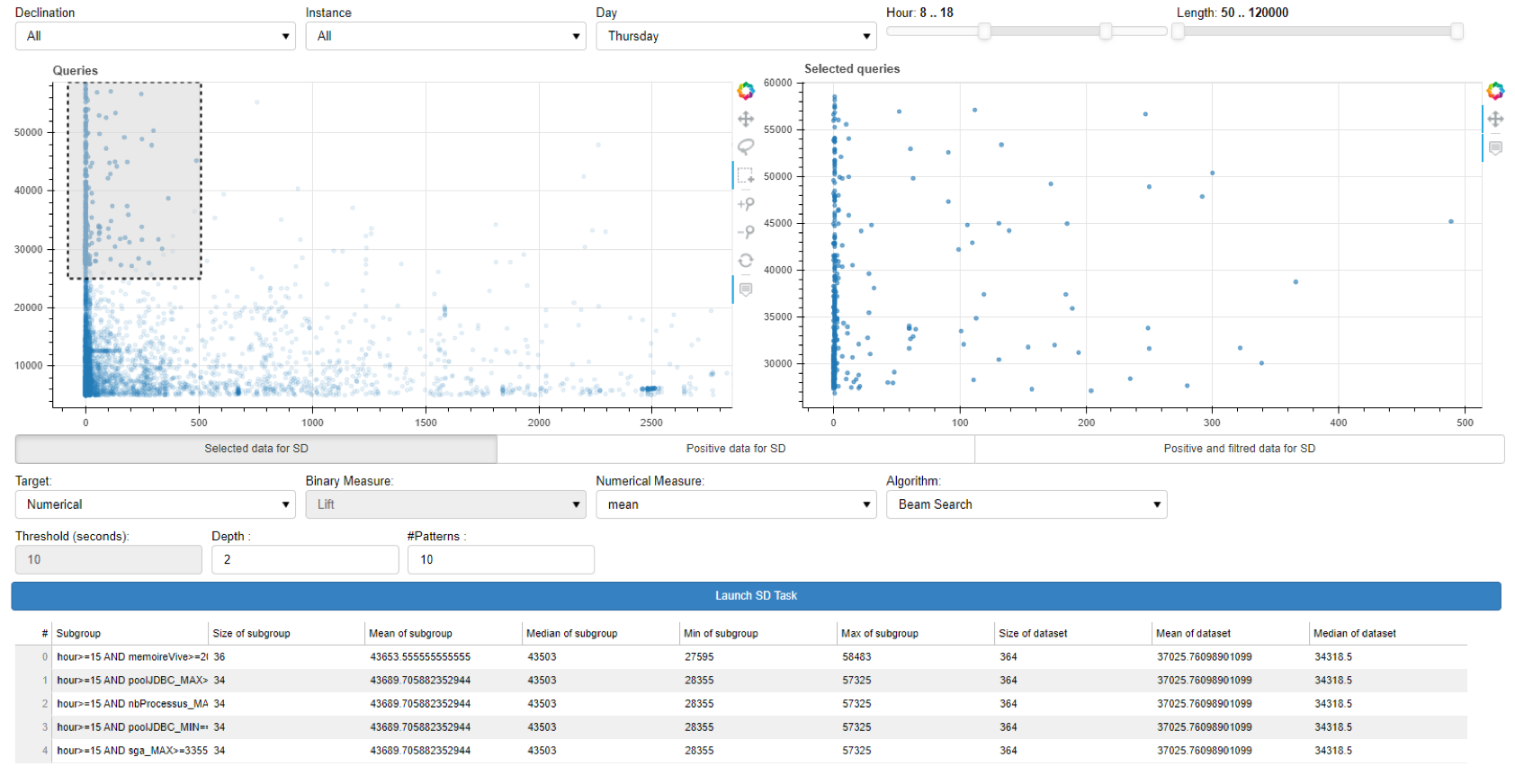What makes my queries slow?: Subgroup Discovery for SQL Workload Analysis (International Conference on Automated Software Engineering ASE, Core A*)
In this work we adressed SQL workload analysis problem to pinpoint schema issues and improve performances. We seek to automatically identify subsets of queries that share some properties only i.e a pattern (e.g., sql clauses and/or environment features) and foster at the same time some target measures, such as execution time or concurrency issues. To this aim, we design a generic-framework rooted on a data mining approach known as Subgroup Discovery. This work has been published in the 36th IEEE/ACM International Conferenceon Automated Software Engineering (ASE).
In this framework we :
- propose a data preprocessing step to parse queries but also augment them with relevant features.
- provide heuristic and exact algorithms to identify relevant subgroups of interest w.r.t a target problem (e.g higher execution time) with a diverse set of interestingness measures.
- integrate a visual tool to enable the user to interact iteratively with the framework.
Our experimental study was conducted on an SQL workload containing Hibernate queries run on our clients' servers at INFOLOGIC company.
We use the readily available Mozilla Parser which provides only an SQL syntactic tree in XML that constitue the input of our customized parser. The syntactic tree is mined using Depth First stratergy to identify for each query clause its associated attributes. Moreover, we extended the Mozilla parser in two other ways:
- considering Hibernate queries used in our ERP as the ORM layer by adding relative keywords for Hibernate such as JOIN-FETCH.
- handling nested queries and keeping alias (temporary table names) to differentiate between attributes having the same name but belong to different tables or clauses.
First we need to install the customized parser by executing the following command:
pip install -e ./Code/extened-mozilla-parser/moz-sql-parser-hackHere is one example:
import os
import sys
from query_parser import parsing
query = 'select count( distinct a.ik) from fr.infologic.ventes.commandesfactures.modele.CdeLig as a where a.cde.typCde = :p1 and a.typLigGenere != :p2 and a.typLigGenere != :p3 and a.art.refDefaut = :p4 and (a.cde.cliLiv = :p5 or 9596436491 in elements (a.cde.noCliContrat)) and ( a.cde.etatContrat in ( :collection0_ ) ) and ( a.etatContrat NOT in ( :collection1_ ) ) and UPPER ( a.libStd ) like UPPER( :p6 ) and a.dossierInfo.dosRes = :p7'
print(parsing(query)){'tables_from': ['fr.infologic.ventes.commandesfactures.modele.cdelig'],
'tables_join': [],
'projections': ['fr.infologic.ventes.commandesfactures.modele.cdelig.ik'],
'atts_where': ['fr.infologic.ventes.commandesfactures.modele.cdelig.cde.typcde',
'fr.infologic.ventes.commandesfactures.modele.cdelig.typliggenere',
'fr.infologic.ventes.commandesfactures.modele.cdelig.typliggenere',
'fr.infologic.ventes.commandesfactures.modele.cdelig.art.refdefaut',
'fr.infologic.ventes.commandesfactures.modele.cdelig.cde.cliliv',
'fr.infologic.ventes.commandesfactures.modele.cdelig.cde.noclicontrat',
'fr.infologic.ventes.commandesfactures.modele.cdelig.cde.etatcontrat',
'fr.infologic.ventes.commandesfactures.modele.cdelig.etatcontrat',
'fr.infologic.ventes.commandesfactures.modele.cdelig.libstd',
'fr.infologic.ventes.commandesfactures.modele.cdelig.dossierinfo.dosres'],
'atts_groupby': [],
'atts_orderby': [],
'atts_having': [],
'functions': ['count']}
We show below a simple use case (dataset d-3) considered in the paper:
import pandas as pd
from subgroup_discovery import sd_binary_conds
queries = pd.read_csv(saved_path + 'dataset-d3.csv')
result_binomial = sd_binary_conds(queries, dict_conds = {},_
target = 'conc_disc',
mesure = 'Binomial',
depth = 1,
threshold = 10000,
result_size = 100,
algorithm = 'Beam Search',
beam_width = 100,
features_ignore = ['concurrence'])
res_binomial = result_binomial.to_dataframe()
print(res_binamial[:6])the corresponding results are shown below :
As the framwork does not provide closed patterns, a post-processing step is more than needed to group patterns having the same extent. We used hierarchical clustering based on the Jaccard similarity. Here is an example that shows how to perform clustering on the resulting patterns :
similarity_dendrogram(result_binomial.to_descriptions(), 20, queries)In practice, an effective SD approach needs to be iterative and interactive, to make it possible to incorporate subjective criteria as well as human expertise. We present our basic interactive tool so it can manage different data types, both for input features as well as the target, including nominal and numerical attributes. It also provides a range of interestingness measures and algorithms.
If you are using sd-4sql or our provided dataset for your research, please consider citing our paper:
Y. Remil, A. Bendimerad, R. Mathonat, P. Chaleat, and M. Kaytoue, "what makes my queries slow?": Subgroup discovery for sql workload analysis. in Proceedings of 36th IEEE/ACM International Conference on Automated Software Engineering (ASE). IEEE, 2021.
bibtex:
@inproceedings{remiletalASE21,
title={"What makes my queries slow?": Subgroup Discovery for SQL workload Analysis},
author={Remil, Youcef and Bendimerad, Anes and Mathonat, Romain and Chaleat, Philippe and Kaytoue, Mehdi},
booktitle={Proceedings of 36th IEEE/ACM International Conference on Automated Software Engineering (ASE)},
year={2021},
organization={IEEE}
}



